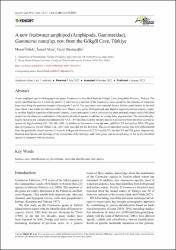A new freshwater amphipod (Amphipoda, Gammaridae), Gammarus tumaf sp. nov. from the Gokgol Cave, Turkiye
Citation
Özbek, M., Aksu., İ. & Baytaşoğlu, İ. (2023). A new freshwater amphipod (Amphipoda, Gammaridae), Gammarus tumaf sp. nov. from the Gokgol Cave, Turkiye. Zoosystematics and Evolution, 99(1), 15-27. http://doi.org/10.3897/zse.99.89957Abstract
A new amphipod species belonging to the genus Gammarus is described from the Gokgol Cave, Zonguldak Province, Turkiye. The newly-identified species is relatively small (13 mm) and is a member of the Gammarus pulex-group by the presence of numerous long setae along the posterior margins of pereopods 3 and 4. The specimens were sampled from a shallow pond located in the dark zone (about 1 km inside the entrance) of the cave. Minute eyes, setose (both peduncle and flagellar segments) second antenna, slight-ly swollen flagellar segments of the second antenna, setose pereopods 3 and 4 and relatively short endopod/exopod ratio of the third uropod are the character combination of the newly-identified species in addition to lacking body pigmentation. The molecular phy-logeny, based on the concatenated dataset (28S+COI, 1495 bp) indicated that the new species was resolved from the other Gammarus species by high bootstrap (NJ: 100, ML: 100). In addition to Gammarus tumaf sp. nov., mtDNA COI and nuclear DNA 28S gene data of Gammarus baysali ozbek et al., 2013 were recorded for the first time. The newly-identified species was well-differentiated from the genetically closest species, G. baysali, with genetic distance of 12.22% and 0.55% for the COI and 28S genes, respectively. Detailed descriptions and drawings of the extremities of the holotype male were given and the morphology of the newly-identified species is compared with its relatives.


















